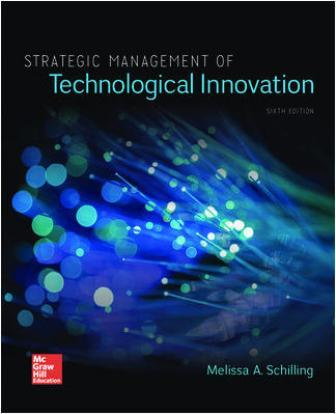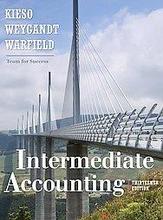Solution Manual for Strategic Management of Technological Innovation, 6th Edition, Melissa Schilling
$55.00
Solution Manual for Strategic Management of Technological Innovation, 6th Edition, Melissa Schilling
Solution Manual for Strategic Management of Technological Innovation, 6th Edition, Melissa Schilling
Table of Contents
Chapter 1
Introduction 1
The Importance of Technological Innovation 1
The Impact of Technological Innovation on Society 2
Innovation by Industry: The Importance of Strategy 4
The Innovation Funnel 4
The Strategic Management of Technological Innovation 6
Summary of Chapter 9
Discussion Questions 10
Suggested Further Reading 10
Endnotes 10
PART ONE INDUSTRYDYNAMICS OF TECHNOLOGICALINNOVATION 13
Chapter 2 Sources ofInnovation 15
The Rise of “Clean Meat” 15
Overview 19
Creativity 20
Individual Creativity 20
Organizational Creativity 22
Translating Creativity Into Innovation 24
The Inventor 24
Innovation by Users 26
Research and Development by Firms 27
Firm Linkages with Customers, Suppliers, Competitors, andComplementors 28
Universities and Government-Funded Research 30
Private Nonprofit Organizations 32
Innovation in Collaborative Networks 32
Technology Clusters 33
Technological Spillovers 36
Summary ofChapter 37
DiscussionQuestions 38
Suggested Further Reading 38
Endnotes 39
Chapter 3 Types andPatterns of Innovation 43
Innovating in India: The Chotukool Project 43
Overview 46 Types ofInnovation 46
Product Innovation versus Process Innovation 46
Radical Innovation versus Incremental Innovation 47
Competence-Enhancing Innovation versus Competence-DestroyingInnovation 48
Architectural Innovation versus Component Innovation 49
Using the Dimensions 50
Technology S-Curves 50
S-Curves in Technological Improvement 50
S-Curves in Technology Diffusion
53 S-Curves as a Prescriptive Tool 54
Limitations of S-Curve Model as a Prescriptive Tool 55
Technology Cycles 56
Summary of Chapter 62
Discussion Questions 63
Suggested Further Reading 63 Endnotes 64
Chapter 4 StandardsBattles, Modularity, and PlatformCompetition 67
A Battle for Dominance in Mobile Payments 67
Overview 71 WhyDominant Designs Are Selected 71
Learning Effects 72
Network Externalities 73
Government Regulation 76
The Result: Winner-Take-All Markets 76
Multiple Dimensions of Value 77
A Technology’s Stand-Alone Value 78
Network Externality Value 78
Competing for Design Dominance in Markets with Network Externalities 83
Modularity and Platform Competition 87
Modularity 87 PlatformEcosystems 89
Summary of Chapter 91Discussion Questions 92
Suggested Further Reading 92
Endnotes 93
Chapter 5 Timing ofEntry 95
UberAIR 95
Overview 98
First-Mover Advantages 98
Brand Loyalty and Technological Leadership 98
Preemption of Scarce Assets 99
Exploiting Buyer Switching Costs 99
Reaping Increasing Returns Advantages 100
First-Mover Disadvantages 100
Research and Development Expenses 101
Undeveloped Supply and Distribution Channels 101
Immature Enabling Technologies and Complements 101
Uncertainty of Customer Requirements 102
Factors Influencing Optimal Timing of Entry 104
Strategies to Improve Timing Options 108
Summary of Chapter 108
Discussion Questions 109
Suggested Further Reading 109
Endnotes 110
PART TWO FORMULATINGTECHNOLOGICAL INNOVATION STRATEGY 113
Tesla, Inc. in 2018 115
Overview 123
Assessing the Firm’s Current Position 123
External Analysis 123
Internal Analysis 127
Identifying Core Competencies and Dynamic Capabilities 131
Core Competencies 131
The Risk of Core Rigidities 132
Dynamic Capabilities 133
Strategic Intent 133
Summary of Chapter 137
Discussion Questions 138
Suggested Further Reading 139
Endnotes 139
Chapter 7 Choosing Innovation Projects 141
Where Should We Focus Our Innovation Efforts?An Exercise 141
Overview 146
The Development Budget 146
Quantitative Methods For Choosing Projects 149
Discounted Cash Flow Methods 149
Real Options 152
Disadvantages of Quantitative Methods 154
Qualitative Methods for Choosing Projects 154
Screening Questions 155
The Aggregate Project Planning Framework 157
Q-Sort 159
Combining Quantitative and Qualitative Information 159
Conjoint Analysis 159
Data Envelopment Analysis 161
Summary of Chapter 163
Discussion Questions 163
Suggested Further Reading 164
Endnotes 164
Chapter 8 Collaboration Strategies 167
Ending HIV? Sangamo Therapeutics and Gene Editing 167
Overview 175
Reasons for Going Solo 175
1. Availability ofCapabilities 176
2. Protecting ProprietaryTechnologies 176
3. Controlling Technology Development and Use 176
4. Building and RenewingCapabilities 177
Advantages of Collaborating 177
1. Acquiring Capabilities and Resources Quickly 177
2. Increasing Flexibility 178
3. Learning from Partners 178
4. Resource and Risk Pooling 178
5. Building a Coalition around a Shared Standard 178
Types of Collaborative Arrangements 178
Strategic Alliances 179
Joint Ventures 181
Licensing 182
Outsourcing 183
Collective Research Organizations 184
Choosing a Mode of Collaboration 184
Choosing and Monitoring Partners 187
Partner Selection 187
Partner Monitoring and Governance 191
Summary of Chapter 192
Discussion Questions 193
Suggested Further Reading 193
Endnotes 194
Chapter 9 Protecting Innovation 197
The Digital Music Distribution Revolution 197
Overview 201Appropriability 202
Patents, Trademarks, and Copyrights 202
Patents 203
Trademarks and Service Marks 207
Copyright 208
Trade Secrets 210
The Effectiveness and Use of Protection Mechanisms 211
Wholly Proprietary Systems versus Wholly Open Systems 212
Advantages of Protection 213
Advantages of Diffusion 215
Summary of Chapter 218
Discussion Questions 219
Suggested Further Reading 219
Endnotes 220
PART THREEIMPLEMENTING TECHNOLOGICAL INNOVATION STRATEGY 223
Chapter 10 Organizingfor Innovation 225
Organizing for Innovation at Google 225
Overview 227
Size and Structural Dimensions of the Firm 228
Size: Is Bigger Better? 228
Structural Dimensions of the Firm 230
Centralization 230Formalization and Standardization 231
Mechanistic versus Organic Structures 232
Size versus Structure 234
The Ambidextrous Organization: The Best of Both Worlds? 234
Modularity and “Loosely Coupled” Organizations 236
Modular Products 236
Loosely Coupled Organizational Structures 237
Managing Innovation Across Borders 240
Summary of Chapter 243
Discussion Questions 244
Suggested Further Reading 244
Endnotes 245
Chapter 11 Managingthe New Product Development Process 249
Scrums, Sprints, and Burnouts: Agile Development at Cisco Systems 249
Overview 252
Objectives of the New Product Development Process 252
Maximizing Fit with Customer Requirements 252
Minimizing Development Cycle Time 253
Controlling Development Costs 254
Sequential versus Partly Parallel Development Processes 254
Project Champions 257
Risks of Championing 257
Involving Customersand Suppliers in the Development Process 259
InvolvingCustomers 259
InvolvingSuppliers 260
Crowdsourcing 260
Tools for Improving the New Product Development Process 262
Stage-GateProcesses 262
Quality FunctionDeployment (QFD)—The House of Quality 265
Design forManufacturing 267
Failure Modes andEffects Analysis 267
Computer-AidedDesign/Computer-Aided Engineering/Computer-Aided Manufacturing 268
Tools for MeasuringNew Product Development Performance 269
New ProductDevelopment Process Metrics 271
Overall InnovationPerformance 271
Summary ofChapter 271
DiscussionQuestions 272
Suggested FurtherReading 272
Endnotes 273
Chapter 12 ManagingNew Product Development Teams 277
Innovation Teams at the Walt Disney Company 277
Overview 279
Constructing New Product Development Teams 280
Team Size 280 TeamComposition 280
The Structure of New Product Development Teams 285
Functional Teams 285Lightweight Teams 286
Heavyweight Teams 286
Autonomous Teams 286
The Management of New Product Development Teams 288
Team Leadership 288
Team Administration 288
Managing Virtual Teams 289
Summary of Chapter 292
Discussion Questions 292
Suggested Further Reading 293
Endnotes 293
Chapter 13 Crafting a Deployment Strategy 297
Deployment Tactics inthe Global Video Game Industry 297
Overview 306
Launch Timing 306
Strategic LaunchTiming 306
Optimizing Cash Flowversus Embracing Cannibalization 307
Licensing and Compatibility 308
Pricing 310
Distribution 312
Selling Direct versus Using Intermediaries 312
Strategies forAccelerating Distribution 314
Marketing 316
Major Marketing Methods 316
Tailoring the Marketing Plan to Intended Adopters 318
Using Marketing toShape Perceptions and Expectations 320
Summary of Chapter 323
Discussion Questions 324
Suggested Further Reading 324
Endnotes 325
Be the first to review “Solution Manual for Strategic Management of Technological Innovation, 6th Edition, Melissa Schilling” Cancel reply
Related products
Solution Manual












Reviews
There are no reviews yet.